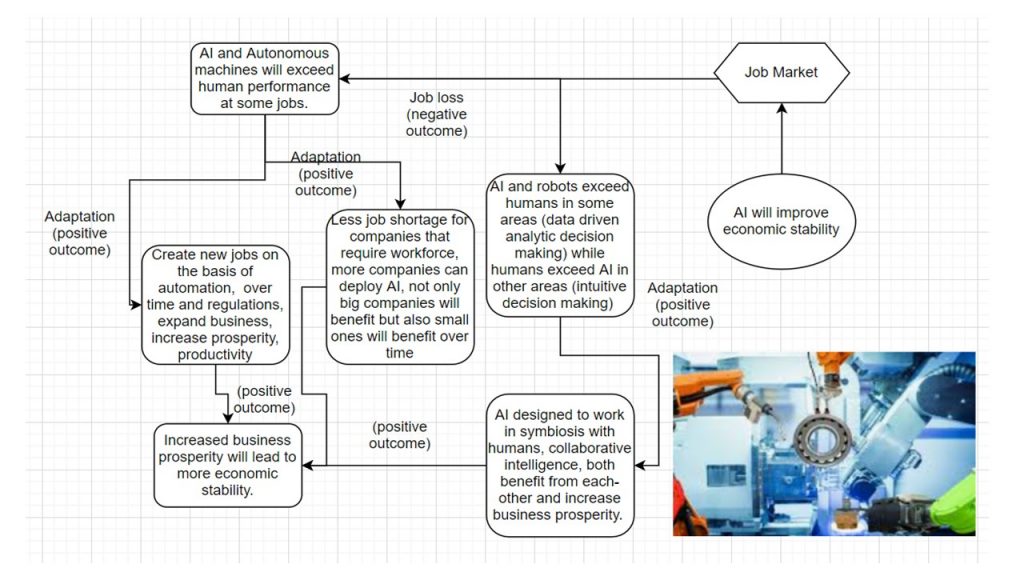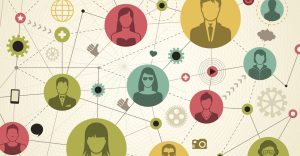Introduction
As recent technological advancements have propelled at an enormous rate, AI which benefits from these advancements hands-on, has taken the center stage and is considered one of the leading technologies of this century, with a major impact on society and people’s lives. The human and machine interaction but also symbiosis has increased drastically these past few years and since the popularization of computers in the 1980s with a focus on a single non-technical user, the digital transformation of the world has led to the usage of machines not only for task automation but also in decision making and analytics as the recent changes in AI have been employed by many companies, large-scale to small-scale. Many people but also researchers and experts of AI fear that with the rise of super-intelligent and more autonomous AI, machines might match or even exceed human intelligence and capabilities on tasks such as complex decision-making, reasoning and learning, sophisticated analytics, pattern recognition, visual acuity, speech recognition and language translation. While this does spark controversy regarding the role of AI in society and the job market it also encompasses the threat of AI machines replacing humans in their day to day activity and a potential job loss.
AI and the potential risk in the job market
From autonomous vehicles to recommender systems, AI and machines are rapidly starting to precede human capability and efficiency, with automation being one of the major aspects of this transition but also AI’s large capacity, decision making and analytical skills. While it is certain that we must adapt to these changes the main controversy on this issue remains whether AI will be beneficial to us in the future and create new jobs and opportunities or result in a potential job loss and socio-economic crisis. In order to come to a possible conclusion, we need to analyze the different aspects of this issue and the different factors that come into play.
In order to nurture our understanding on the impact of AI in the job market and economy but also create a better understanding about whether AI can surpass human capabilities and replace humans in more complex decision-making tasks and eventually more difficult jobs that encompass a wide-range of jobs, we need to obtain a perspective of what the future technology of AI can accomplish, based on our current technological advancements in creating more and more intelligent machines and where do these systems lack the upper-hand against humans.
With automation having replaced many jobs in the past but also opened up a lot more, which may be long-term as adapting to these new circumstances might be difficult as first, Oxford Economics has predicted that up to 20 million manufacturing jobs worldwide will be lost to robots by 2030, while on the other hand the World Economic Forum has predicted that automation will displace 75 million jobs but generate 133 million new ones worldwide by 2022 and Gartner, a world’s leading research and advisory company, has predicted that AI-related job creation will reach two million net-new jobs in 2025.
According to The Wall Street Journal, The Impact of Artificial Intelligence on the World Economy, a report by McKinsey Global Institute describes that AI could lead to a gross GDP growth of around 26 percent or $22 trillion by 2030. The report states that the major contributors to this figure are the automation of labor, which could add up to 11 percent or around $9 trillion to global GDP by 2030, and innovations in products and services, which could increase GDP by about 7 percent or around $6 trillion by 2030.

However, the report adds that in addition to its economic benefits, AI will also lead to significant disruptions for workers, companies and economies and there will likely be considerable costs associated with managing labor-market transitions, especially for workers being left behind by AI technologies, which could reduce the gross impact of AI by around 10 percentage points, leading to the aforementioned net GDP increase of 16 percent or $13 trillion by 2030.

Another point made by the author of the above-mentioned article is that AI deployment is still in its early stages, and considerable innovations and investments are still required for the wider deployment in fields like robotics, health care, self-driving cars, military, public safety and other applications. The downside is that the adaptation rates are not the same for different companies and different states, with US and China being the world leading states with the highest potential to deploy AI applications at a larger scale, keeping in mind that also the most technologically powerful companies fall under their wing.

The issue, stands with the gap that is enlarged between these leading states and companies and their proponents, which one could say starts at the worker level with the training and education needed to adapt to these new changes and requirements. Needless to say, in this technologically driven era with AI playing a major role, the above claims are just stating the inevitable. However, to put things at ease and provide a sense of comfort, the author acknowledges a November 2017 conference on AI and the Future of Work, in which MIT professor Erik Brynjolfsson explained that : “Such S-curve deployment patterns are fairly typical of transformative, general purpose technologies like the steam engine, electricity and computing. Their deployment time-lags are longer because attaining their full benefits requires a number of complementary co-inventions and investments, including additional technologies, applications, processes, business models, and regulatory policies.”
The aforementioned article by Irving Wladawsky-Berger on WSJ quotes McKinsey noting that : “If delivered, this impact would compare well with that of other general-purpose technologies through history. Consider, for instance, that the introduction of steam engines during the 1800s boosted labor productivity by an estimated 0.3 percent a year, the impact from robots during the 1990s around 0.4 percent, and the spread of IT during the 2000s 0.6 percent.”

The article states that the McKinsey report is based on simulation models of the impact of AI at the country, sector, company and worker levels. Furthermore, it adds that the report looked at the adoption of five broad categories of AI technologies: computer vision; natural language; virtual assistants, robotic process automation, and advanced machine learning. Finally, it concludes by asserting that the report used data sources including survey data from approximately 3,000 firms in 14 different sectors and economic data from a number of organizations including the United Nations, the World Bank and the World Economic Forum.

In order to nurture our understanding of what the future technology of AI can accomplish, regarding the notion of High-level Machine Intelligence (HLMI) achieved by machines that can accomplish every task better and more efficiently than humans workers, a scientific research paper by Grace, Katja, et al. “When will AI exceed human performance? Evidence from AI experts.” suggests that advances in artificial intelligence (AI) will transform modern life by reshaping transportation, health, science, finance, and the military. The results of the report in the paper come from a large survey of machine learning researchers on their beliefs about progress in AI.
Researchers predict AI will outperform humans in many activities in the next ten years, such as translating languages (by 2024), writing high-school essays (by 2026), driving a truck (by 2027), working in retail (by 2031), writing a bestselling book (by 2049), and working as a surgeon (by 2053). Researchers believe there is a 50% chance of AI outperforming humans in all tasks in 45 years and of automating all human jobs in 120 years, with Asian respondents expecting these dates much sooner than North Americans. Some researchers also fear the intelligence explosion which may be a cause of HLMI, where even the task of researching AI might be taken over by AI, will radically increase the speed at which AI evolves and while this might seem an issue of the future and probably far-fetched, experts believe that prioritizing the research towards minimizing the risk of AI on society and economy is crucial in order to prevent the rapid growth of AI technology negatively impact the economy and job-market.
AI and opportunities in the job market
With the risk of automation in general but also AI replacing jobs in the near future becoming more prevalent, the need to adapt to these changes and overcome these challenges remains crucial in the long-term. The scientific community is well-aware of these issues and many big companies are also working towards minimizing these risks, with one example being Amazon that confirms it will spend $700 million to train about 100,000 workers in the US by 2025, helping them move into more highly skilled jobs.
In addition to the adaptation policies undertaken by companies who have already deployed AI at a larger scale, experts in different fields are coming together in order to provide guidance through their expertise for companies struggling to adapt to these changes, in the present but also for the future. David Madden, the author of the paper Automation and Robots: Good or Bad? for Industry Today, on his final point made in the article “The Bottom Line: Put Employees at Ease”, states:

If you’re toying with the idea of upgrading to an automated workforce and know that this could come at a cost to your existing workers, the best thing you can do is be upfront and transparent with employees. You’ll also want to develop a strategy for how to create human-assisted robotic systems that maximize both your human resources and new technologies at the same time.
To ease employees’ worries, be sure to emphasize the fact that even the most cutting-edge warehouse automation mechanisms are designed to complement and aid human workers, at least for the time being. At its core, warehouse automation should eliminate worker injury and fatigue while boosting overall productivity. This can be seen as a win-win for businesses and their employees.
David Madden, efficiency expert, Founder and President of Container Exchanger and ExchangerHub.

While AI has the upper hand on certain tasks, many new jobs or opportunities are being created and many more will be created in the future where AI can work together with humans, both benefiting from each other in order to optimize the workflow and lead to a more optimal and beneficial working environment, combining the analytical, data-driven AI decision-making with the intuitive, fast thinking decision-making of humans which excels in ambiguous situations , in terms of uncertainty, complexity and equivocality in the working environment.
With a greater computational information processing capacity and an analytical approach, AI can extend human’s cognition when addressing complexity, whereas humans can still offer a more holistic, intuitive approach in dealing with uncertainty and equivocality in organizational decision making. This premise mirrors the idea of intelligence augmentation, which states that AI systems should be designed with the intention of augmenting, not replacing, human contributions.
Mohammad Hossein Jarrahi, Artificial intelligence and the future of work: Human-AI symbiosis in organizational decision making
Conclusion

While it is true that in the future, with the rapid growth of AI and advancements in technology, many people’s jobs will be replaced by AI machines that can outperform the former, the negative impact on socio-economic factors remains an issue and while many believe that the developing pace of technology in general but also AI technology will facilitate this impact, others including myself are optimistic about the opportunities and positive change AI will provide for the job market and economy in general, while everyone agrees that adapting to these major changes that affect us in different levels will take time and that research towards minimizing this impact and engineering beneficial AI should be prioritized in the future.

